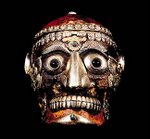
Dr Lemoyne and his retort
Prothero vividly describes the ensuing scene in "Purified By Fire" ps33-34:
"After Mr. Wolfe, the fireman who had started feeding the furnace with coke at two o'clock in the morning, declared the machinery ready, the guests took one last look at the body. Someone pulled the sheet down a bit, exposing a face with a horribly pained countenance. After this final, grotesque viewing, Olcott, LeMoyne, and two other men appointed to usher the body into the furnace took off their hats, as if to signal that whatever reverence might be mustered should be expended forthwith. Members of the impromptu congregation dutifully removed their bowlers. Then the body was lifted and "solemnly borne" across the threshold of the two-room crematory into the furnace room, and cremation's rite of passage to America was underway. Olcott, in his capacity as high priest, soaked the white sheet covering the corpse with water saturated in alum in an effort to prevent both the body's immediate blazing and any further public display of the baron's nakedness. In a nod to the Asian origins of cremation and the Theosophist's love of Mother India, someone placed a simple clay urn--"the present of a friend in the East"--atop the furnace. Olcott then sprinkled the body with spices, including cassia, cinnamon, cloves, frankincense, and myrrh. According to one confused reporter, the Theosophist was "following the Egyptian ceremonials, with a touch of the Indian, Greek and Roman customs." But he was also bequeathing to the occasion a vaguely Christian air--playing the Wise Man bringing spices from the East. Finally, Olcott placed on the corpse a collection of roses, smilax, primroses, and palms, as well as evergreens as a symbol, he announced, of the immortality of the soul. Recalling perhaps the Christian tradition of burying lay people with their heads to the west so they could look to the east for the Second Coming, Olcott and LeMoyne debated whether it was more auspicious to place the body into the furnace head-first or feet-first. The fireman and the crematory's builder then joined the procession, forming a coterie of six pallbearers, as in a traditional burial. At approximately 8:30 A.M. they slid the baron's body into the retort head-first.
There was a momentary sizzle and a bit of smoke. But soon the door was cemented shut and the furnace made airtight. The evergreens and the hair around the head caught on fire, and "the flames formed," according to the Times reporter, "a crown of glory for the dead man." At first witnesses were repelled by the smell of burning flesh, but soon the sweeter aromas of flowers and spices banished foul odors from the room. Witnesses who peered through a peephole in the side of the furnace noted that the flowers were almost miraculously reduced to ash without losing their "individual forms." About an hour into the proceedings a rose-colored mist enveloped the body. Later the mist turned to gold. Meanwhile, the corpse became red-hot and then transparent and luminous. All these effects lent to the retort "the appearance of a radient [sic] solar disk of a very warm. . . color." After some time yet another intimation of immortality pressed itself on the witnesses: "the palm boughs. . . stood up as naturally as though they were living portions of a tree." Then the left hand of the baron rose up and three of his fingers pointed skyward. The scientists present later attributed this incident to involuntary muscular contractions, but others saw in it something of a spiritual phenomenon. The main event concluded officially at 11:12 A.M., when Dr. Folsom, secretary of the Massachusetts Board of Health, formally pronounced the incineration complete. All that remained of the body had fallen lifelessly to the bottom of the retort, but the ashes of a few sprigs of evergreen remained, seemingly suspended in air above the iron cradle. Cremationists interpreted this too as a propitious sign."

Now that is what I call a story. I did say in a recent posting that I'd try to steer away from thanatological matters but then Prothero's book is an excellent one and this is a tale which, in my view, is of some historical significance and interest.
Bone Idle

No comments:
Post a Comment